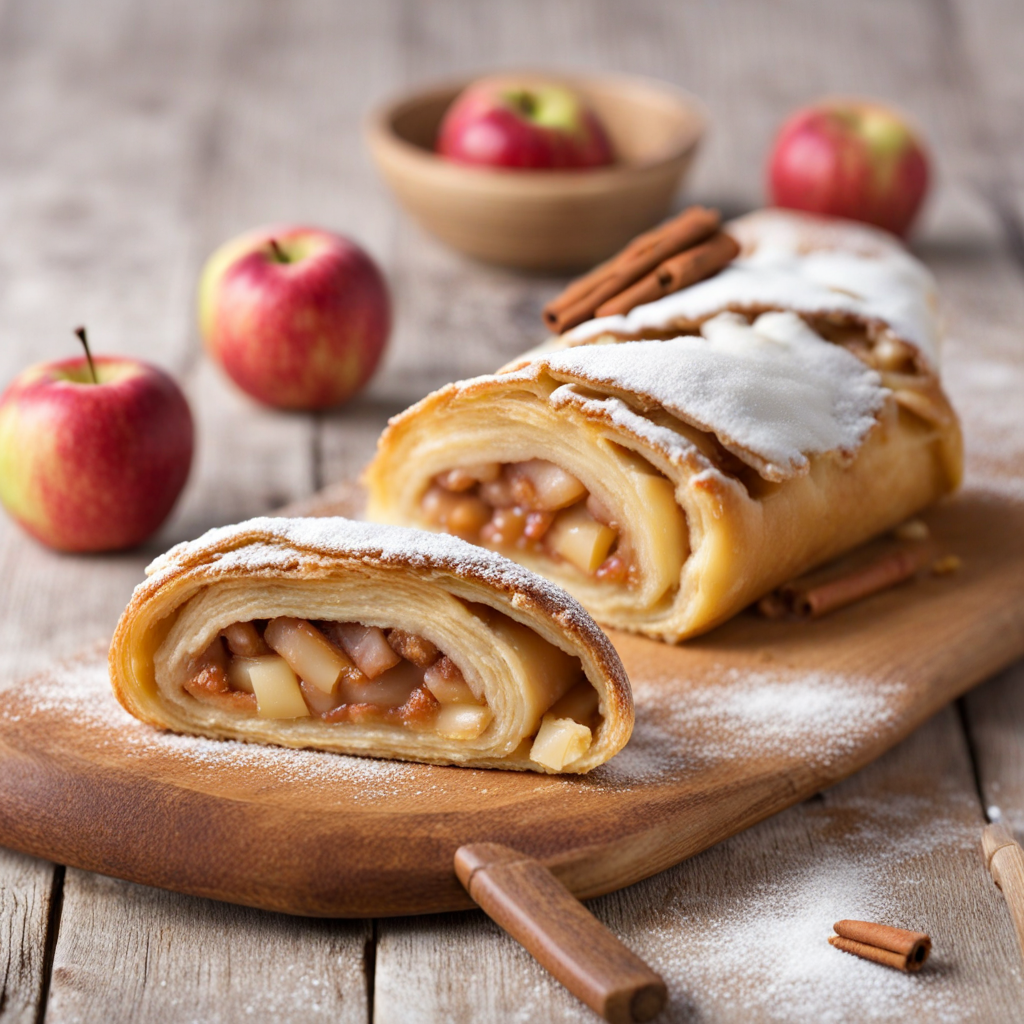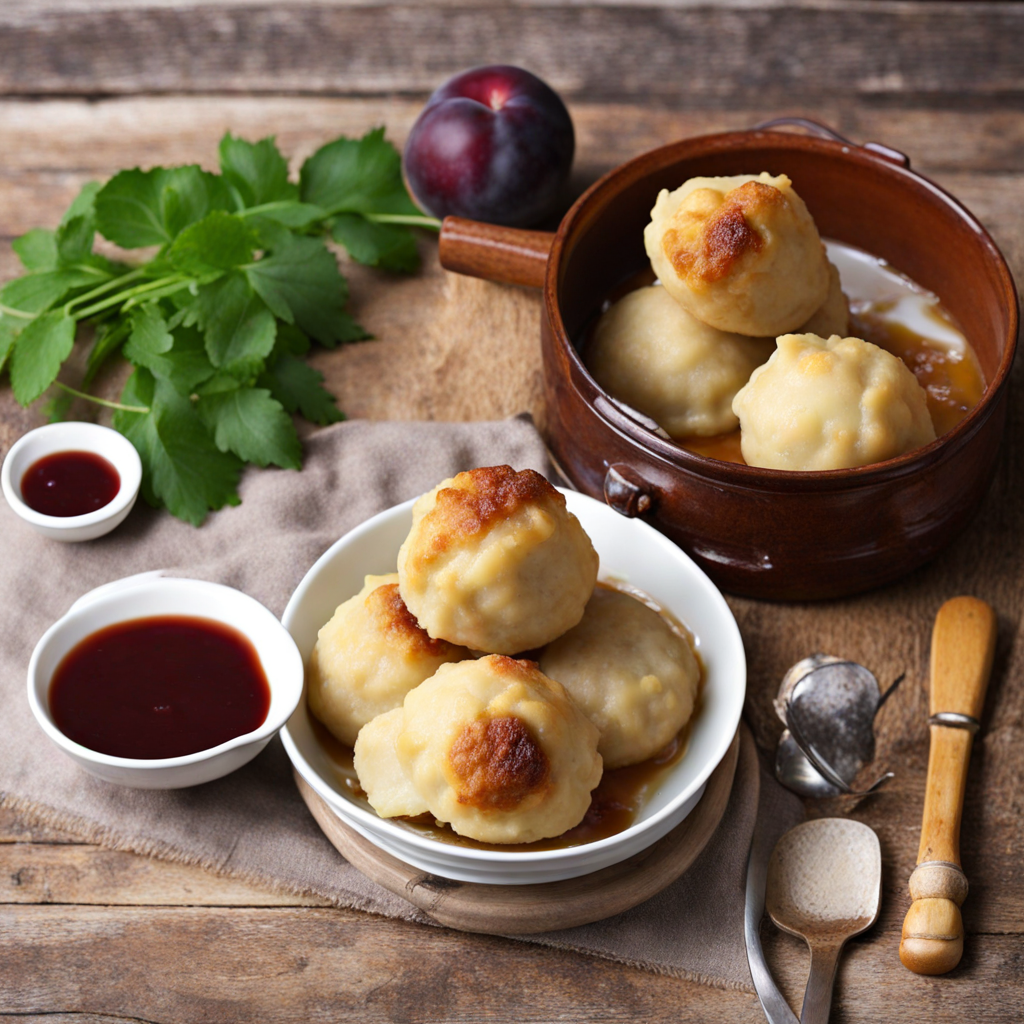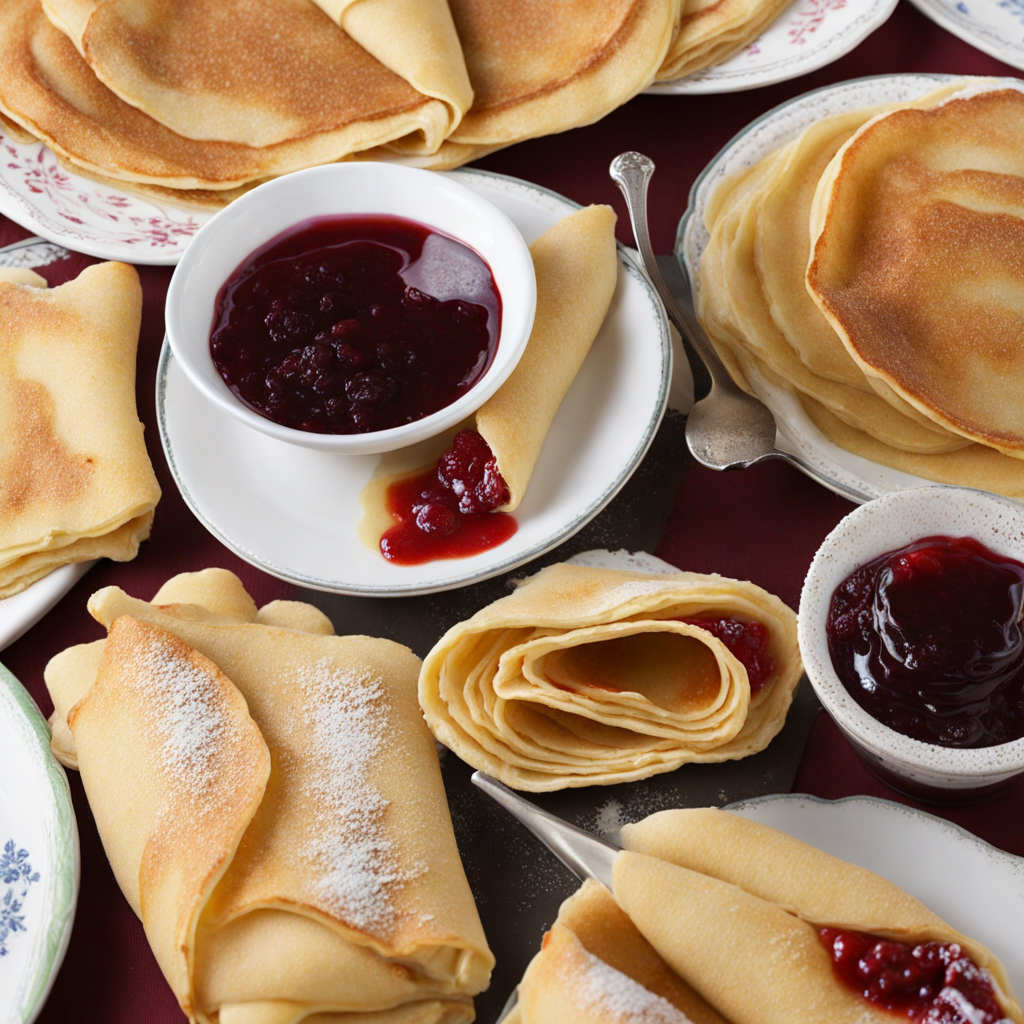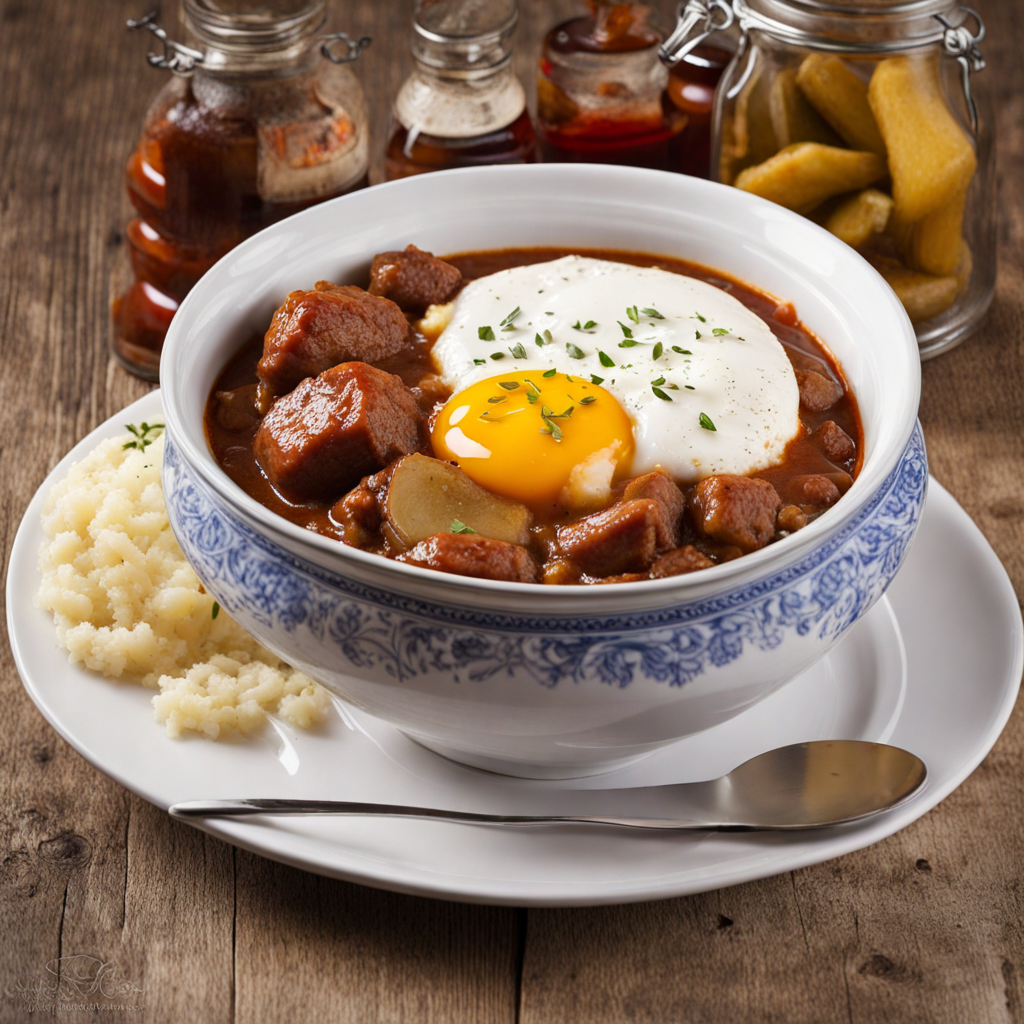Apfelstrudel
Apfelstrudel, a traditional Austrian pastry, is a delightful dessert that encapsulates the essence of Central European baking. This iconic dish features a thin, flaky dough that is expertly rolled out to create a delicate layer that envelopes a sweet and spiced apple filling. The dough is often made with flour, water, and a touch of oil or butter, which contributes to its unique texture and allows it to achieve that perfect balance of crispiness and tenderness when baked. The strudel is typically dusted with powdered sugar before serving, adding a touch of sweetness that complements the flavors within. The filling of Apfelstrudel primarily consists of tart baking apples, such as Granny Smith or Boskoop, which are sliced and mixed with sugar, cinnamon, raisins, and sometimes a hint of lemon juice for a refreshing zing. The combination of sweet and tart flavors, along with the warm spices, creates a harmonious taste experience that transports you to the heart of Austria. Each bite reveals a burst of juicy apple goodness enveloped in layers of buttery, flaky pastry, making it an irresistible treat for pastry lovers. Served warm, Apfelstrudel is often accompanied by a generous dollop of whipped cream, vanilla sauce, or a scoop of vanilla ice cream, enhancing its rich flavors and adding a creamy contrast to the flaky pastry. Whether enjoyed as a comforting dessert after a hearty meal or as a delightful afternoon snack with a cup of coffee or tea, Apfelstrudel offers a taste of Austrian hospitality and tradition that is both comforting and indulgent.
How It Became This Dish
The Enchanting History of Apfelstrudel: Austria’s Iconic Dessert Apfelstrudel, or apple strudel, is more than just a dessert; it is a cultural emblem that encapsulates centuries of culinary evolution and a rich tapestry of history. Originating from the lands of the Habsburg Empire, this delightful pastry combines simple ingredients to create a dish that is both comforting and sophisticated. Its journey reflects the broader culinary trends and social changes in Central Europe, particularly in Austria. #### Origins: A Culinary Mosaic The origins of Apfelstrudel can be traced back to the 17th century, although its roots are deeply intertwined with various cuisines across Europe. The word 'strudel' itself is derived from the German word for 'whirlpool,' which aptly describes the swirling layers of pastry filled with apples. The technique of stretching dough thinly to create delicate layers is reminiscent of ancient Middle Eastern pastries, such as baklava, which traveled to Europe through the Ottoman Empire. The earliest references to strudel-like pastries appear in Austrian cookbooks from the 1690s. However, the apple filling that we recognize today as quintessentially strudel was likely influenced by the abundance of apples in the region. The Habsburg Empire, which spanned much of Central and Eastern Europe, was a melting pot of cultures, and this culinary exchange contributed to the evolution of Apfelstrudel. While the sweet apple filling was favored by the Austrians, other variations emerged, incorporating nuts, cherries, or poppy seeds, showcasing the versatility of the dish. #### Cultural Significance: A Symbol of Austria As Apfelstrudel gained popularity, it became a symbol of Austrian national identity. By the 19th century, it was firmly entrenched in Viennese cuisine, appearing in cafes and bakeries throughout the city. Its association with the Viennese coffee house culture made it an important social dish, often enjoyed with a cup of coffee or tea. The dessert became emblematic of the culinary sophistication of the Austrian Empire, where coffee houses served as cultural hubs for intellectuals, artists, and the bourgeoisie. The strudel, with its delicate layers and rich flavors, was a reflection of the era's emphasis on refinement and pleasure in gastronomy. The dish became a staple not only in Austrian households but also in the broader culinary repertoire of Central Europe, influencing neighboring countries such as Hungary, Czechia, and Slovenia. #### The Recipe: Craft and Tradition The traditional preparation of Apfelstrudel involves a labor-intensive process that highlights the craftsmanship of the baker. The pastry dough, made from flour, water, and a touch of fat (often butter or oil), is kneaded until smooth and then stretched into an almost translucent sheet. This labor of love is crucial, as the thin layers of dough create the signature flakiness of the strudel. The filling typically consists of tart apples, sugar, cinnamon, raisins, and breadcrumbs. The apples used are often varieties that hold their shape when cooked, such as Granny Smith or Boskoop. The combination of sweet and tart flavors, complemented by the aromatic spices, creates a harmonious balance that has delighted palates for generations. Once the dough is stretched, the filling is spread evenly, and the strudel is carefully rolled up, forming a log that is then baked until golden and crisp. The final touch is a dusting of powdered sugar, which adds a touch of elegance to the presentation. #### Evolution and Modern Adaptations While Apfelstrudel has retained its classic appeal, it has also adapted to changing tastes and dietary preferences over the years. In the 20th century, particularly post-World War II, the dish experienced a renaissance as culinary traditions were revived and celebrated across Europe. In Austria, Apfelstrudel became a symbol of national pride, especially during the 1950s and 60s, when tourism began to flourish. The global spread of Austrian cuisine led to the introduction of Apfelstrudel in restaurants and bakeries around the world. Variations began to emerge, incorporating local ingredients and flavors. For instance, in the United States, it became common to find strudel made with different fruits or even savory fillings, appealing to a broader audience. In recent years, there has been a resurgence of interest in traditional baking techniques and recipes. Artisan bakers and home cooks alike are revisiting the classic methods of making Apfelstrudel, often sharing their knowledge through workshops and cookbooks. This revival is not just about nostalgia; it reflects a growing appreciation for handmade, authentic food in an era dominated by convenience and fast food. #### Apfelstrudel Today: A Culinary Icon Today, Apfelstrudel stands as a beloved dessert in Austria and beyond, celebrated not only for its taste but also for its cultural significance. It has become a staple at festive occasions, family gatherings, and holiday celebrations. In Austria, it is often served with a side of vanilla sauce or whipped cream, enhancing its indulgent nature. The strudel has also found its way into modern gastronomy, appearing on menus of upscale restaurants that fuse traditional recipes with contemporary culinary techniques. Chefs experiment with flavors and presentations while respecting the traditional aspects that make Apfelstrudel so cherished. Culinary festivals in Austria frequently feature Apfelstrudel, celebrating its place in Austrian heritage. These events serve not only as a platform for showcasing the dish but also as an opportunity for community engagement, where locals and tourists alike gather to enjoy the flavors of Austria. #### Conclusion: A Journey Through Time The history of Apfelstrudel is a fascinating journey through time, reflecting the complexities of cultural exchange, culinary innovation, and national identity. From its humble beginnings as a pastry influenced by various European traditions to its status as an iconic symbol of Austrian cuisine, Apfelstrudel embodies the spirit of a region that has long valued food as a means of connection and expression. As we savor a slice of this exquisite pastry, we partake in centuries of tradition, craftsmanship, and shared experience. Apfelstrudel is not just a dessert; it is a story of resilience, adaptation, and the joy of coming together around the table. In every flaky layer, we find a piece of history, a taste of culture, and a reminder of the enduring power of food to unite us all.
You may like
Discover local flavors from Austria







